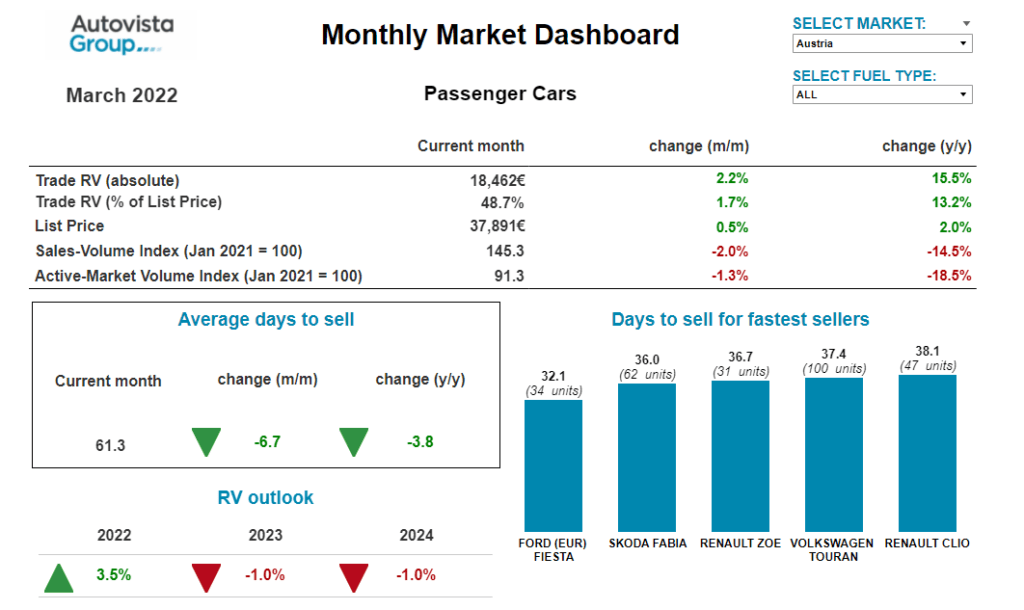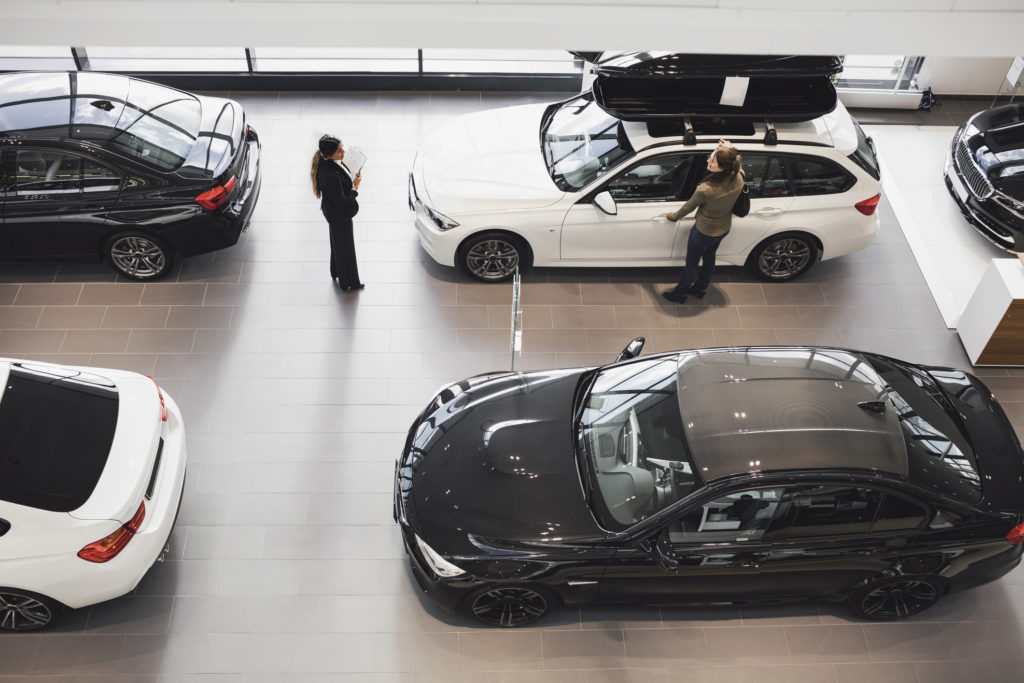Monthly Market Update: European used-car prices grow in March ahead of Ukraine war impact
31 March 2022

Used-car sales were weaker in March than a year ago in most west European automotive markets. However, with ongoing supply constraints, residual values (RVs) enjoyed modest growth.
Autovista Group’s used-car coverage in the monthly market dashboard features Austria, France, Germany, Italy, Spain, Switzerland, and the UK. It also includes a breakdown of key performance indicators by fuel type, average new-car list prices, as well as sales-volume and active market-volume indices.
War in Ukraine impacts supply and demand
Since Russia invaded Ukraine on 24 February, oil prices and, in turn, fuel prices at the pump have risen sharply across Europe. This is adding higher vehicle-running costs to the mounting inflationary pressure on household budgets. There is also the potential for higher list prices for new cars as raw-material costs such as palladium (used in catalytic converters) and nickel (used in electric-vehicle batteries) have spiked.
The sanctions imposed on Russia will also have economic implications, which will further threaten new-car demand. The financial squeeze may entice more automotive consumers to switch to used cars or simply delay a purchase decision, whether new or used.
The war in Ukraine has also added another layer of disruption to fragile automotive supply chains, with carmakers such as the BMW and Volkswagen (VW) groups suspending production during March.
Mercedes-Benz told Autovista24 it ‘is working with suppliers in Ukraine, who supply the company with various components for vehicle production.’ The carmaker said that ‘currently all plants are running almost without restrictions’ but did confirm adjustments to ‘shift plans in some areas of the Sindelfingen, Germany and Kecskemét, Hungary plants.’
‘Mercedes-Benz is monitoring the situation closely and remains in close contact with suppliers to work intensively on solutions for safeguarding supply chains. This includes, among other things, transferring production to other locations within the supplier network. The high flexibility of the plants will also be used to avoid downtime as much as possible,’ the company added.
As Ukraine is a vital source of neon gas, which is used in the lithography stage of chip manufacturing, the reduced supply is adding to the pre-existing challenge of sourcing semiconductors for automotive production. This is indirectly affecting manufacturers in the region, including Ford and Volvo Cars. Replying to Autovista24, Volvo explained that it has ‘very limited direct relationships with suppliers in the affected areas [Russia and Ukraine], and we have not seen any impact on supply or production volumes so far. We continue to monitor the situation.’
Although no additional production stoppages have been announced in recent days, the outlook for new-car registrations in Europe’s key markets is weaker than previously anticipated. This will also reduce the stock levels of used cars and RVs could therefore benefit, but this also assumes used-car demand remains high.
The Autovista Group residual-value outlook for 2022 has been upgraded in Germany, Italy, and Spain this month. Conversely, the UK RV outlook has been downgraded as market activity is notably subdued. The outlook for Austria and Switzerland is maintained, so too is France after an upward revision last month.
Further RV growth in Austria
The Austrian used-car market continues to be underpinned by stable demand and low supply. On average across all passenger cars aged two-to-four years, the supply volume in March was 18.5% lower than in March 2021, notes Robert Madas, Eurotax (part of Autovista Group) regional head of valuations, Austria, Switzerland, and Poland. Already in 2021, the supply was significantly lower than at the beginning of 2020.
Diesel cars in particular are missing from the market, with a drop of almost 27.6% compared to March 2021. The supply of petrol cars has increased slightly year on year but remains at a low level compared to market activity. The supply of hybrids of all types and battery-electric vehicles (BEVs) has increased only slightly compared to the beginning of 2021, but market activity shows strong demand, leaving the supply somewhat short.
In the context of used-car demand outstripping supply, average days to sell have decreased significantly compared against February, to an average of 61.3 days. BEVs are selling the fastest, averaging 53.3 days, followed by hybrid-electric vehicles (HEVs) with 55.5 days. Plug-in hybrids (PHEVs) are selling the slowest, averaging 78.6 days.
This market environment has led to a further increase in RVs of 36-month-old cars. They have risen by 13.2% year-on-year, with cars retaining 48.7% of their list price on average. Petrol cars are currently leading with a trade value of 50%, followed by HEVs (49.5%) and diesel cars (48.7%). 36-month-old BEVs are the lowest with 41.5%.
Madas predicts market parameters will not change in the medium term, because new-car registrations are still markedly lower than before the crisis (2021 was down 27% compared to 2019). However, Madas acknowledges that the further disruption to new-car supply, this time due to the war in Ukraine, will be the key factor in the future development of RVs. ‘Supply chains are already affected and together with the semiconductor shortage this will lead to even longer delivery times for most new vehicles,’ he said.
Due to this undersupply, RVs for three-year-old passenger cars will probably continue to rise this year. Only when the new-car market picks up significantly, and thus volumes on the used-car market also increase, are values likely to come under pressure. Madas believes this will probably not be the case before 2023.
French used-car market stabilising
With slightly lower average RVs than last month, the French used-car market is broadly stabilising. This is in sharp contrast to the second half of 2021, when used-car prices rose sharply. The average number of selling days has also stabilised, at 53.5 days, ‘as the market cannot sustain the growth rates achieved between July and December 2021,’ noted Ludovic Percier, RV and market analyst, Autovista Group France.
RVs of petrol cars are following the general market trend, while diesel prices are still increasing slightly and will continue to grow. However, rising fuel prices because of the war in Ukraine are encouraging people to switch to electric vehicles (EVs).
‘Carmakers are offering interesting leasing offers on EVs, although this is to take advantage of the current situation and is not expected to continue over time. Electric vehicles are an alternative for now, but it will be interesting to see how this trend develops in the coming months. They are not yet a viable solution for the future as the charging infrastructure is insufficiently developed in France,’ commented Percier.
The residual values of BEVs decreased a lot at the end of 2021 as emissions targets forced carmakers to register a larger number of new cars before the end of the year. Any 36-month-old models available on the used-car market are not as efficient as new BEVs, especially in terms of range. However, values are rising again as the constrained supply is encouraging buyers to take what is available on the used-car market as the new-car market offer is lower than it should be.
PHEVs are following the overall market trend, but there are differences across brands and segments, with high-volume premium cars generating lower RVs. PHEVs are expected to suffer the greatest decline of all powertrains in 2023, when 36-month-old fleet cars enter the used-car market, especially in the summer months. ‘PHEVs are mostly chosen for fiscal reasons in France, as the list-price uplift compared to standard hybrids is not justified for customers,’ Percier concluded.
German used-car market ‘worsening’
‘The situation on the German used-car market is worsening in various dimensions, sometimes unnoticed,’ highlights Andreas Geilenbruegge, head of valuations and insights at Schwacke (part of Autovista Group).
On the one hand, the shortage of supply still dominates the business and used-car prices remain high, especially for internal-combustion engine (ICE) cars. ‘A tendency can now be observed in the case of ICE cars, whereby the vehicles on offer are at significantly higher prices than outgoing ones, i.e. significantly more expensive units are coming in than are being sold,’ notes Geilenbruegge.
Stock days continue to be advantageous for internal-combustion engine vehicles, but this is exacerbating the supply problem and makes sourcing a challenge. For BEVs, unfortunately, expensive offer-price levels and rising stock days are being witnessed. This suggests that, at least for the time being, a cost ceiling seems to have been reached for these vehicles that consumers are prepared to pay. It is also noticeable that the supply of BEVs is stagnating, if not slightly declining. ‘There should be no shortage of supply, but exports perhaps provide more lucrative business at the moment,’ commented Geilenbruegge.
Production stoppages due to the war in Ukraine are creating further turbulence as well as a strange imbalance between rivals, with some carmakers explicitly demonstrating their delivery capability. ‘This used to be a bad sign of overcapacity and is now putting customer brand loyalty to the test. Nevertheless, retailers, after two years of drought, will certainly prefer to make a sale of a deliverable model with a minimally lower margin, than to dream of a promising model with a potentially higher return’ Geilenbruegge concluded.
War in Ukraine delays RV stabilisation in Italy
Residual values in Italy only increased slightly last month, by 0.3% compared to February, yet compared to a year ago, the increase is as high as 13.5%. The various consequences of COVID-19 are still creating production and delivery problems. But now the conflict in Ukraine is slowing down GDP growth and adding further inflationary pressure in Italy.
‘This will slow the return to a pre-crisis situation, and therefore also a stabilisation of residual values, which are now expected to increase by 2.9% in 2022 compared to 2021,’ explains Marco Pasquetti, forecast and data specialist, Autovista Group Italy.
The average time to sell a used car has further decreased. In March, it took less than 49 days, over three days fewer than a year ago. The Peugeot 308 was the fastest-selling used car, spending only 23 days in stock.
The biggest increase in used-car prices compared to March 2021 is for diesel models, with RVs growing by an average of 27.6% in value terms. PHEV values are growing at a slower pace than most other powertrains, with sales volumes down 47.1%, but advertised volumes up 53%. Sales of BEVs, on the other hand, are rising faster than stock levels. ‘Residual values are still significantly lower than in 2021, but we expect this will change in the second half of the year,’ Pasquetti commented.
Imports provide relief in Spain
Although still far from the volume of previous years, a supply recovery is already visible in Spain, with greater availability to respond to used-car demand. On one hand, the semiconductor crisis appears to be easing. On the other, imports have increased considerably (+35% in 2021). ‘This gives the market some oxygen while stabilising prices,’ explains Ana Azofra, Autovista Group head of valuations and insights, Spain.
This stabilisation is already visible in petrol and diesel models. In contrast, it has not yet reached HEVs, which started their upward trend later and have not yet reached their peak. Their average prices improved again in March in value-retention terms, up 1% compared to last month, and are almost 7% higher than a year ago. The current value of a three-year-old old 60,000km HEV stands at €17,700 on average, retaining 59% of its new price.
Slightly positive, albeit slower, is the RV evolution of PHEVs and BEVs, which continue to be weighed down by high list prices, the lack of charging infrastructure, and the continuing rise in electricity prices. Nevertheless, their RVs are expected to continue to grow slowly over the coming months.
‘Latest developments in Ukraine point to a near future marked by product scarcity and inflation, so our forecasts for the end of 2022 are now positive for all powertrain types, including BEVs and PHEVs,’ Azofra added.
Modest supply improvements in Switzerland
For one and a half years, the Swiss used-car market has been characterised by stable demand, low supply, and rising used-car prices. On average across all two to four-year-old passenger cars, the supply volume in March was 5.9% below the level of a year earlier but improved compared to February, notes Hans-Peter Annen, head of valuations and insights, Eurotax Switzerland (part of Autovista Group). Already in 2021, the supply was significantly lower than at the beginning of 2020.
Despite improving supply of most fuel types, diesel cars in particular are missing from the market, with active-market volumes 28.9% down compared to March 2021. For petrol cars, however, there are 6.6% more two to four-year-old cars offered than a year ago, and for hybrids of all types, market activity remains particularly high compared to the current supply. The supply of PHEVs and BEVs has increased significantly since the beginning of 2021, but PHEV demand continues to exceed supply. For BEVs too, supply is higher than a year ago (+18.3%) but still lower than demand.
The average days to sell remained stable in March. A used car aged two to four years is currently in stock for 62 days. HEVs are selling quickest with an average of 56 days, followed by petrol cars with 60 days, diesels with 66 days, and BEVs and PHEVs with 80 days.
This market environment has led to a further increase in the average residual-value percentage (%RV) of 36-month-old passenger cars, to 47.7% (+16.8% compared to March 2021). Petrol cars posted strong year-on-year %RV gains of 16.8%, to 48.8%, as too did diesel cars (up 16% to 45.8%).
The added disruption to the supply of new cars stemming from the war in Ukraine, will be a key factor in the future development of RVs. As new-car registrations will remain markedly lower than before the COVID-19 pandemic (2021 was down 23.4% compared to 2019), the market parameters will not change in the medium term. Annen predicts that RVs of three-year-old used cars will continue to rise this year, before eventually stabilising and declining through 2023 and 2024.
UK used-car market weakens
The average residual value of a three-year-old car was over 40% higher than a year ago in March. However, the UK’s used-car market weakened during the month and values were stable.
‘Since the turn of the year, auction activity has been subdued, with weaker conversion rates than vendors were accustomed to for most of 2021, but hammer prices have remained relatively stable,’ explained Jayson Whittington, Glass’s (part of Autovista Group) chief editor, cars and leisure vehicles. ‘Throughout March though, hammer prices came under pressure too and, consequently, Glass’s residual values are falling.’
Several factors that could be affecting consumer’s willingness to spend money on big-ticket items. Whilst the UK is more insulated from the impact of Russia’s invasion of Ukraine than some European countries, it will certainly not help inflation, with fuel costs rising further and prices of agricultural produce increasing too.
However, there are other domestic factors that will have a greater bearing on consumers’ ability to spend, such as significant rises in the cost of utilities from April, together with uncertainty around planned tax rises. ‘Both of these issues are likely to have already influenced consumer confidence and may, at least in part, explain current used-car activity,’ surmised Whittington.
It took on average 54.2 days for a dealer to retail a three-year-old used car in March. This is broadly similar to last month, but 1.2 days longer than a year ago. This is an especially poor result considering the UK experienced a lockdown in March 2021.
Glass’s predicted a market plateau, which has materialised, but there are indications of a struggle, with residual values expected to begin depreciating from April. There is no suggestion that the market is facing a crash in used-car prices, but the outlook is less positive than it has been for 12 months, with rising utility bills and taxation increases set to hit the UK from April. Russia’s invasion of Ukraine is also putting additional pressure on fuel prices at the pump, adding to already rising inflation.
The March 2022 monthly market dashboard provides the latest pricing, volume and stock-days data.




